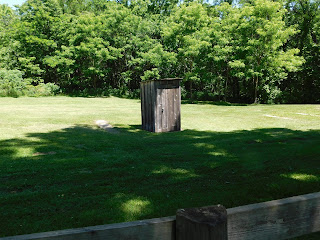This is the entrance to the Jesse James farmhouse, owned and operated by Clay County Missouri. Our friend and fellow Heartland owner, Roy Evans, lived in the basement below the museum building for several years while he worked as a Deputy Sheriff.
The new siding has been peeled back to reveal the original log home style used.
This is a home in town where Jesse lived and where he died.
Jesse was straightening this picture when he was shot in the head from behind. In the top center of the frame below, you can see a bullet hole.
An artist's perception of what happened when Jesse died.
Jesse's body was tied in an upright position in this house, which was opened to the public for viewing.
Jesse's original place of burial, on the family-owned farmhouse property. It is noted that Jesse's mother's bed was placed in the front room of the house in position for her to see the plot and frequently she woke in the night to run looker away.
This photo of Jesse's mother standing beside the original marker over the grave. The marker was more than 7 feet tall originall.
This is all that remains of the original marker.
This is the bank building that was the site of the first daylight bank robbery in American history and attributed to the James gang.
The original teller windows.
Jesse Woodson James (September 5, 1847 – April 3, 1882) was an American outlaw,guerrilla, gang leader, bank robber, train robber, and murderer from the state of Missouri and the most famous member of the James-Younger Gang. Jesse and his brother Frank James were Confederate guerrillas or bushwhackers during the Civil War. They were accused of participating in atrocities committed against Union soldiers, including the Centralia Massacre. After the war, as members of various gangs of outlaws, they robbed banks, stagecoaches, and trains.
The James brothers were most active as members of their own gang from about 1866 until 1876, when as a result of their attempted robbery of a bank in Northfield, Minnesota, several members of the gang were captured or killed. They continued in crime for several years, recruiting new members, but were under increasing pressure from law enforcement. On April 3, 1882, Jesse James was killed by Robert Ford, a member of his own gang who hoped to collect a reward on James' head. Already a celebrity when he was alive, James became a legendary figure of the Wild West after his death.
Despite popular portrayals of James as an embodiment of Robin Hood, robbing from the rich and giving to the poor, there is no evidence that he and his gang shared their loot from the robberies they committed. Scholars usually place his actions in the context of regional insurgencies of ex-Confederates following the Civil War rather than a manifestation of alleged economic justice or of frontier lawlessness.
Thank you Wikipedia
So long.

























No comments:
Post a Comment